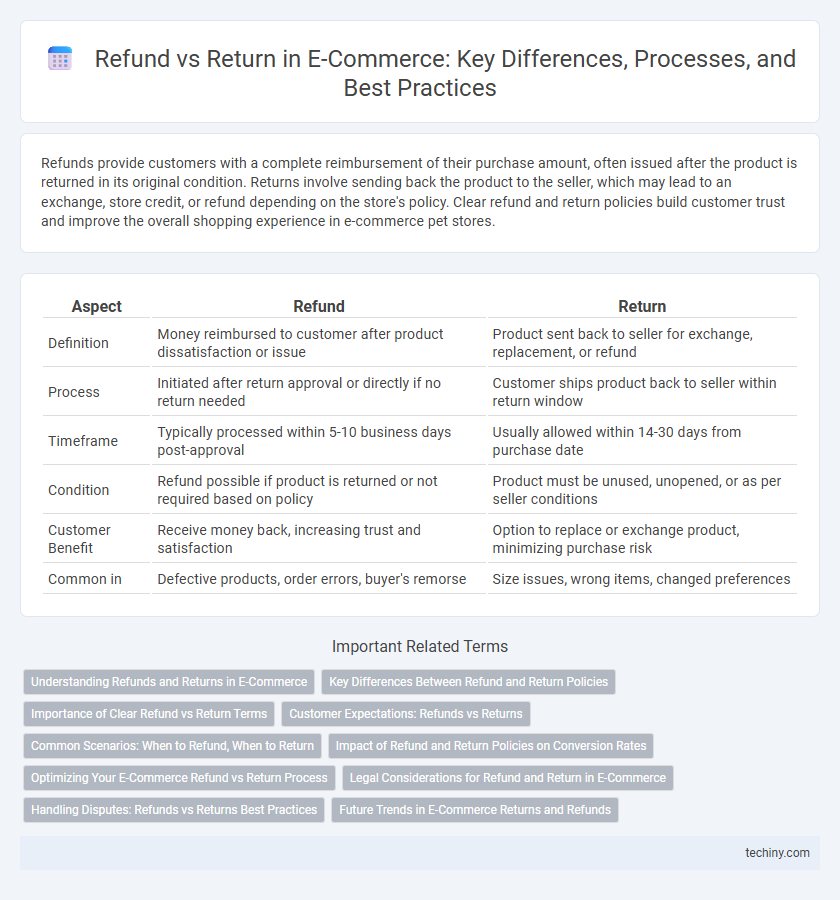Refunds provide customers with a complete reimbursement of their purchase amount, often issued after the product is returned in its original condition. Returns involve sending back the product to the seller, which may lead to an exchange, store credit, or refund depending on the store's policy. Clear refund and return policies build customer trust and improve the overall shopping experience in e-commerce pet stores.
Table of Comparison
| Aspect | Refund | Return |
|---|---|---|
| Definition | Money reimbursed to customer after product dissatisfaction or issue | Product sent back to seller for exchange, replacement, or refund |
| Process | Initiated after return approval or directly if no return needed | Customer ships product back to seller within return window |
| Timeframe | Typically processed within 5-10 business days post-approval | Usually allowed within 14-30 days from purchase date |
| Condition | Refund possible if product is returned or not required based on policy | Product must be unused, unopened, or as per seller conditions |
| Customer Benefit | Receive money back, increasing trust and satisfaction | Option to replace or exchange product, minimizing purchase risk |
| Common in | Defective products, order errors, buyer's remorse | Size issues, wrong items, changed preferences |
Understanding Refunds and Returns in E-Commerce
Refunds and returns are critical components of e-commerce customer service, ensuring buyer satisfaction and trust. A return involves the customer sending back a product to the seller, often due to defects, wrong items, or dissatisfaction, while a refund is the reimbursement process issued after the returned item is received or a return is approved. Efficient management of returns and refunds reduces cart abandonment rates, enhances customer loyalty, and positively impacts overall e-commerce revenue.
Key Differences Between Refund and Return Policies
Refund policies focus on reimbursing customers for returned goods, ensuring a clear process for receiving payment back, often within a specified time frame such as 30 days. Return policies outline the conditions under which products can be sent back, including eligibility criteria like product condition, original packaging, and restocking fees. Key differences include the emphasis on financial reimbursement in refund policies versus the physical acceptance and inspection of goods in return policies.
Importance of Clear Refund vs Return Terms
Clear refund vs return terms enhance customer trust and reduce disputes by defining eligibility, conditions, and timelines for each process. Detailed policies help streamline order management, minimize chargebacks, and improve overall customer satisfaction in e-commerce. Transparent communication of these terms supports brand reputation and encourages repeat purchases.
Customer Expectations: Refunds vs Returns
Customer expectations in e-commerce highlight a clear preference for hassle-free refunds over returns, as refunds provide immediate financial reassurance and foster trust. Buyers anticipate transparent refund policies with quick processing times, while returns often involve additional steps such as repackaging and shipping, leading to potential inconvenience. Efficient refund mechanisms significantly enhance customer satisfaction and loyalty, whereas cumbersome return processes may deter repeat purchases.
Common Scenarios: When to Refund, When to Return
In e-commerce, refunds typically occur when customers receive defective or incorrect products, prompting immediate reimbursement without requiring a return; returns are common for items that are unwanted, do not fit, or differ from descriptions, necessitating sending the product back before refund issuance. Scenarios like damaged goods, late deliveries, or subscription cancellations often trigger refunds, while size mismatches, buyer's remorse, or product exchanges involve returns. Clear policies outlining these distinctions enhance customer satisfaction and streamline dispute resolution in online retail operations.
Impact of Refund and Return Policies on Conversion Rates
Clear and customer-friendly refund and return policies significantly boost e-commerce conversion rates by reducing purchase hesitation. Studies show that generous return windows and hassle-free refund processes increase trust and encourage higher average order values. Brands implementing transparent policies often see a 20-30% uplift in repeat purchases and lower cart abandonment rates.
Optimizing Your E-Commerce Refund vs Return Process
Optimizing your e-commerce refund versus return process enhances customer satisfaction and boosts operational efficiency by clearly defining conditions for each option. Implement flexible refund policies that streamline approval times while setting precise return guidelines to minimize reverse logistics costs. Leveraging automated systems for tracking refunds and returns ensures accurate data collection, helping identify trends and prevent fraud, ultimately improving your store's reputation and profitability.
Legal Considerations for Refund and Return in E-Commerce
E-commerce businesses must comply with consumer protection laws such as the Consumer Rights Directive in the EU and the FTC regulations in the US, which mandate clear refund and return policies. Legal considerations require providing a minimum 14-day return period for online purchases, with refunds typically issued within 14 days of receiving the returned item. Failure to adhere to these regulations can result in penalties and damage to reputation in the e-commerce marketplace.
Handling Disputes: Refunds vs Returns Best Practices
Effective handling of disputes in e-commerce requires clear policies distinguishing refunds and returns, emphasizing transparency and responsiveness to enhance customer trust. Implementing automated tracking systems for return shipments and timely refund processing reduces friction and improves dispute resolution efficiency. Prioritizing consistent communication and flexible options tailored to product categories minimizes negative reviews and boosts overall customer satisfaction.
Future Trends in E-Commerce Returns and Refunds
E-commerce returns and refunds are evolving with AI-powered automation enhancing personalized customer experiences and reducing processing times. Blockchain technology is improving transparency and security in refund transactions, fostering greater consumer trust. Future trends indicate increased adoption of sustainable return policies to minimize environmental impact and align with eco-conscious shopper preferences.
Refund vs Return Infographic

 techiny.com
techiny.com